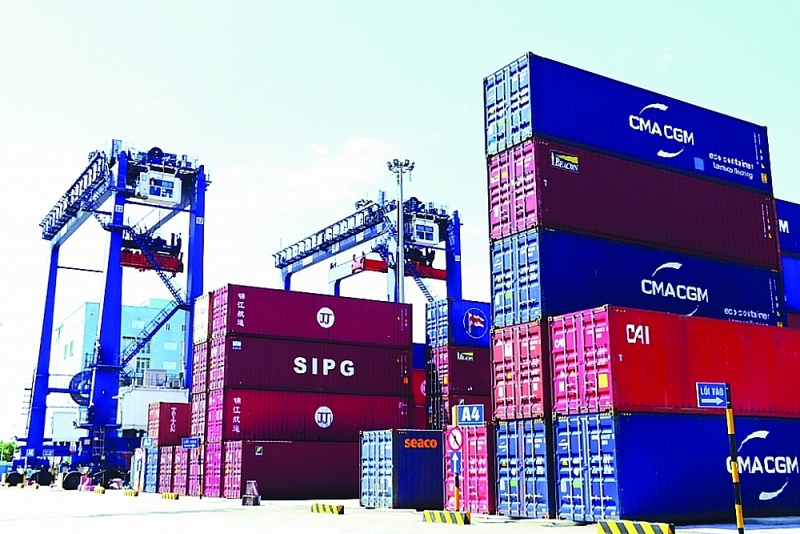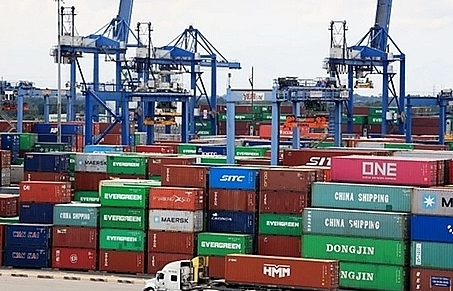Golden opportunities for logistics industry after the pandemic
 |
| High logistics costs are one of the weaknesses that hinder the development of Vietnam's logistics industry. Photo: Ngoc Linh |
Breakthrough
Saigon Tan Cang Corporation is Vietnam’s leading port operator with market share of import-export containers accounting for more than 90% of the southern region and more than 60% of the country.
Evaluating the development opportunities of Vietnam's logistics industry, Truong Tan Loc, Marketing Director, Saigon Tan Cang Corporation, said that Vietnam's economy would continue to recover when socio-economic indicators in the first quarter of 2022 showed growth.
Meanwhile, according to the World Bank's forecast in April 2022, Vietnam's GDP will reach 5.3% in 2022 and then stabilize at around 6.5% in 2023.
The free trade agreements (FTAs) are gradually implemented more effectively, leading to strong growth in Vietnam's import-export market, especially for electronics, machinery and equipment, furniture, plastic, textiles, and seafood.
In general, in the field of transportation, warehousing, postal services, and delivery, Vietnam's logistics market is attracting more than 30,000 enterprises. In particular, most of them are railway, road, and pipeline transport enterprises (59.02%); warehouse enterprises and transport support activities (33.26%); and the remainder are waterway transport enterprises (5.27%), air transport (0.02%), and postal transmission enterprises (2.34%). Notably, there are about 30 transnational logistics services operating in Vietnam with big brands such as DHL, FedEx, Maersk Logistics, APL Logistics, CJ Logistics, and Kuehne + Nagel.
“This is an opportunity to develop port and logistics services to serve the needs of connecting goods with global major markets. The expansion of trade policies makes it easier for foreign companies to penetrate the Vietnamese market, leading to an increase in demand for international quality warehouses, especially special types of warehouses to preserve high-value goods,” said Loc.
Deputy Minister of Industry and Trade Nguyen Sinh Nhat Tan said that up to now, Vietnam has signed many FTAs, including new generation FTAs with high commitments of the parties in all fields, counting traditional and non-traditional.
Their scope is not only confined to commitments to open the commodity market but also in the field of services, investment, and intellectual property. Vietnam's international trade activities have grown strongly, helping to increase import and export turnover, expand markets, and diversify the types of goods participating in import and export. Total import-export turnover from 2010 up to now has increased 4.25 times, from US$157.1 billion in 2010 to US$668.5 billion in 2021.
The latest information from the Ministry of Industry and Trade showed that, despite facing many difficulties due to the pandemic, high transportation costs, and conflict between Russia and Ukraine, Vietnam's export turnover in April 2022 continued to recover strongly, estimated at US$33.26 billion, up 25% over the same period last year. Generally, in the first four months, export turnover was estimated at US$122.4 billion, up 16.4% over the same period last year.
“Thanks to its special geographical position located in the dynamically developing region of the world with a busy flow of goods, Vietnam is favorable to promote production, export, and logistics services, especially after the pandemic is controlled, production and business activities recover and grow again,” said the leader of the Ministry of Industry and Trade.
Some economic experts also believed that Vietnam's logistics industry was welcoming many opportunities from the FTAs and the strong development of e-commerce. Vietnam’s logistics industry is facing golden opportunities after the pandemic. Notably, Vietnamese logistics enterprises have had useful experiences when they overcame the second most difficult year of the pandemic, so the next time will be the time when logistics breaks and thrives.
Accelerate the development of logistics infrastructure
Currently, import-export activities, as well as production and circulation of goods in the country, are strong, which is a good opportunity for logistics enterprises. However, Tran Thanh Hai, Deputy Director of Import and Export Department (Ministry of Industry and Trade), said that most logistics enterprises were small and medium units.
The weakness of businesses now, in addition to capital, is experience and management skills. That is why Vietnamese logistics enterprises still lose in competition as well as are not yet able to reach out to the international market. “Enterprises that provide different stages of the logistics chain such as warehousing and transportation services do not have a chain link. This is also a weakness of Vietnamese enterprises compared to foreign units," said Hai.
According to Mai Xuan Thieu, Chairman of Vietnam Logistics Human Resource Development Association, Vietnam logistics reports in recent years showed that the growth rate of the logistics industry has reached 14 - 16% per year, but logistics costs have been high, equivalent to 15 - 19% of GDP. Thus, improving the capacity of enterprises and cutting logistics costs is a matter of survival to enhance the competitiveness of the economy and each enterprise.
Talking about difficulties and obstacles for businesses, Loc said that the price of fuel increased sharply in 2022 (up about 33% compared to the average price of 2021) affecting the costs of enterprises. Besides, the road transport system has not developed synchronously, and its implementation was slow, which greatly affected the speed of vehicle rotation, the speed of goods movement, and increased the costs of enterprises.
To seize development opportunities, Loc suggested several solutions for logistics infrastructure development, such as continuing to review, supplement, and complete the master plan of Vietnam's inland port system in the 2021 – 2030 period; review, supplement, and complete the overall and detailed planning of the logistics center system in the whole country; and quickly implement road traffic projects, such as Ring Road No. 3, Ring Road No. 4, Bien Hoa - Vung Tau Expressway, and upgrade Ho Chi Minh City - Long Thanh Expressway.
“The government needs to build a mechanism to develop green logistics in the direction of reducing the proportion of fossil fuel use per one km of transport (water or land), contributing to thoroughly implementing the commitment of the Government of Vietnam at COP26, especially developing the inland waterway transport system with current natural advantages, and create a good mechanism for enterprises exploiting watercraft, reducing traffic congestion, saving costs for developing land transport infrastructure, and reducing environmental pollution," said Loc.
Le Thi Ngoc Diep, Head of Trade Department, SLP Vietnam Company, proposed that Vietnam needed to promote technology application in the logistics industry to improve efficiency, optimize operational productivity, and save operating costs for businesses; closely connect development and operational logistics units to improve operational efficiency such as production, warehouse, and transportation units; and encourage investment in Vietnam’s logistics market.
On the side of the Ministry of Transport, Nguyen Cong Bang, Deputy Director of the Department of Transport, affirmed that following the Government's direction, relevant ministries and branches have made efforts to make the best adjustments and reduce cost pressures for businesses.
The Ministry of Transport has established a group related to transportation modes to assess the impact of increased fuel prices, thereby proposing appropriate solutions to the Government and the National Assembly. The price of logistics infrastructure exploitation in Vietnam is relatively uniform. Accordingly, customers can base on services and business lines to make a suitable choice of their logistics services.
| Tran Duc Nghia, Director of Delta International Co., Ltd.: Hoping for a preferential interest program In developed countries, the financial leverage ratio (loan ratio on asset value formed from loans) can be up to 1:6 or 1:7 for the road transport industry when logistics enterprises borrow to buy or financially hire-purchase means of transport to develop services. In Vietnam, this ratio is usually 1:2, if including working capital and fixed capital to invest in a specific purchase loan. This is a huge barrier for small- and medium-sized businesses to grow quickly. In the future, it is necessary to enhance the ability to access capital for logistics businesses to invest in technological innovation and expand operations. Accordingly, businesses want the State Bank to design preferential interest rate programs to support them. Kim Sam Mo, General Director of Kukdong Logistics Company, Chairman of Korea Logistics Association in Vietnam: Vietnam should form an electronic data interchange system Vietnam's logistics market is expected to grow by an average of more than 13% per year by the end of 2022 and continue to grow in the future through foreign investment trends, the application of new technologies, and e-commerce. Currently, the number of logistics enterprises in Vietnam has increased from 37,000 in 2017 to 41,000 in 2020 and is continuing to grow in the fields of transportation, warehousing, customs clearance, and distribution. Korean enterprises wish to cooperate with Vietnamese enterprises in this field. The Korea Logistics Association in Vietnam recommends that Vietnam form an EDI (electronic data interchange) system. In particular, logistics-related parties such as transport companies, warehouses, and customs are connected through a single electronic system so that businesses can receive information quickly and save time in handling operations. Additionally, the Association also recommends standardizing logistics infrastructure services by applying standardized freight rates to improve consumers’ confidence and improve the unification of the toll collection system. Uyen Nhu (recorded) |
Related News

Businesses reduce costs by complying with customs laws
09:18 | 11/10/2024 Customs

Ho Chi Minh City: Determined to become the leading logistics center in the region
09:23 | 06/10/2024 Import-Export

Logistics industry faces green transition imperatives
10:17 | 19/09/2024 Import-Export

Creating a breakthrough for the development of Ho Chi Minh City's service industry
10:19 | 09/08/2024 Import-Export
Latest News

EU partners no longer 'lenient', Vietnam must adapt through ESG policies
09:02 | 05/11/2024 Import-Export

Changes in Canada's trade defense laws
09:00 | 05/11/2024 Import-Export

Import and export are expected to reach 800 billion USD
13:32 | 04/11/2024 Import-Export

Fresh coconuts quenching new overseas markets
13:29 | 04/11/2024 Import-Export
More News

Rice exports likely to set new record in 2024
13:25 | 04/11/2024 Import-Export

Vietnamese goods conquer halal market through trust and quality
09:57 | 04/11/2024 Import-Export

Exporters urged to have strategies to take advantage of UKVFTA for expansion
17:33 | 03/11/2024 Import-Export

Fresh coconuts quenching new overseas markets
17:29 | 03/11/2024 Import-Export

Vietnam and UAE trade sees billion-dollar growth
07:15 | 03/11/2024 Import-Export

Sharing responsibility for ensuring security and safety of the supply chain
07:13 | 03/11/2024 Import-Export

Many factors affecting tuna exports in the last months of the year
19:38 | 02/11/2024 Import-Export

Vietnam still dominates Philippine rice import
19:36 | 02/11/2024 Import-Export
Vietnam cements ties with partners to engage in global semiconductor, AI industries
19:35 | 02/11/2024 Import-Export
Your care

EU partners no longer 'lenient', Vietnam must adapt through ESG policies
09:02 | 05/11/2024 Import-Export

Changes in Canada's trade defense laws
09:00 | 05/11/2024 Import-Export

Import and export are expected to reach 800 billion USD
13:32 | 04/11/2024 Import-Export

Fresh coconuts quenching new overseas markets
13:29 | 04/11/2024 Import-Export

Rice exports likely to set new record in 2024
13:25 | 04/11/2024 Import-Export





